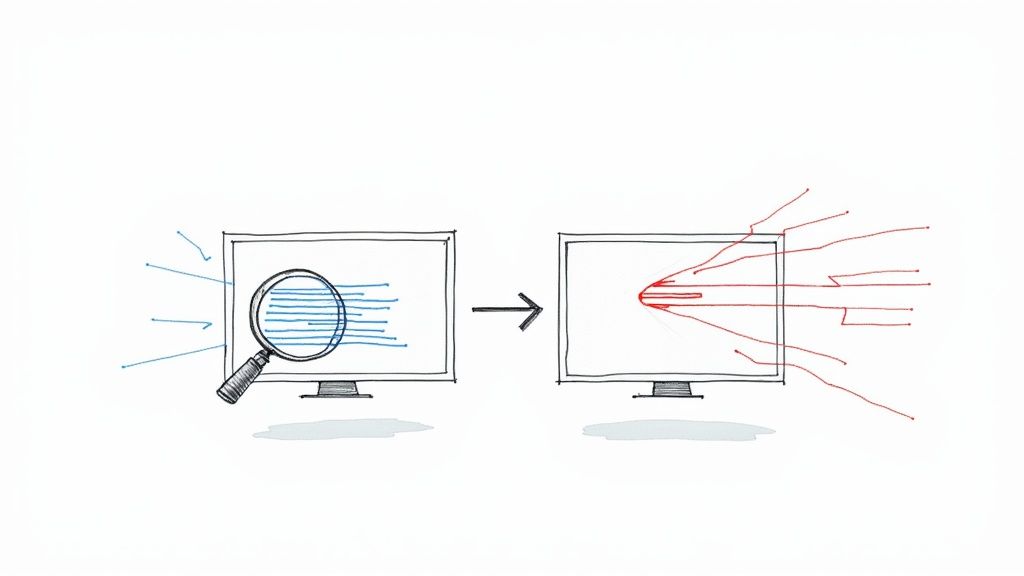How to Improve Code Quality: A Step-by-Step Guide for Modern Development Teams

Understanding the Business Impact of Code Quality

Code quality directly affects a company's success, costs, and team performance. When teams prioritize writing clean, well-structured code, they see improvements across development speed, reliability, and overall business results. Let's explore the key ways code quality impacts the bottom line.
The Relationship Between Code Quality and Development Velocity
Think of working with poor quality code like trying to find your way through a maze blindfolded - it's slow, frustrating, and full of wrong turns. Clean, well-organized code lets developers work quickly and confidently. They can easily understand the codebase, make changes safely, and spot potential issues early.
When code is messy and poorly structured, even simple updates become time-consuming challenges. Developers spend precious hours untangling dependencies and fixing unexpected bugs instead of building new features. The extra time and effort leads to missed deadlines and delayed launches that hurt the business.
Studies of real-world projects show the dramatic difference code quality makes. Analysis of 39 commercial codebases found that high-quality code has 15 times fewer bugs, doubles development speed, and provides 9 times more accurate completion estimates. See the full research here: Measuring the Business Impact of Low Code Quality
Impact on Team Morale and Project Success
The state of the codebase has a direct effect on how developers feel about their work. Clean, maintainable code creates pride and satisfaction. Developers are more engaged when they can focus on solving interesting problems rather than fighting with messy code.
Poor code quality breeds frustration and burnout. When developers constantly struggle with confusing or buggy code, their motivation drops. Many choose to leave for other opportunities, taking valuable knowledge with them and forcing expensive rehiring cycles.
Building a Business Case for Code Quality
While developers understand the importance of code quality, getting buy-in from business stakeholders requires speaking their language. The key is showing how quality code delivers concrete business benefits:
- Lower development costs through faster feature delivery
- Reduced bug fixing and maintenance expenses
- Improved customer satisfaction from more reliable software
- Better employee retention and easier hiring
By connecting code quality to measurable business outcomes, development teams can make a compelling case for investing in quality practices. This leads to sustainable development processes that benefit both the technical team and the broader business goals.
Leveraging Static Analysis Tools for Better Code

Static analysis tools have become essential for catching code issues before they cause problems. These tools scan your code without running it, flagging potential bugs and issues early in development. By finding problems sooner, your team spends less time debugging and more time building new features.
Selecting the Right Tools for Your Stack
The best static analysis tool for your project depends on your specific tech stack. For instance, while ESLint works great for JavaScript projects, you'll need different tools for Python codebases.
Here's what to consider when choosing tools:
- Language-Specific Tools: Focus on one language and offer deep analysis with customized rules
- Multi-Language Tools: Support multiple languages, perfect for projects using different technologies
- Framework-Specific Tools: Check best practices for frameworks like React or Angular
You can make these tools even more effective by adding them to your CI/CD pipeline. Mergify helps automate this process by running checks on every pull request.
Establishing Meaningful Metrics
While static analysis generates lots of data, focus on metrics that directly impact code quality. For example, tracking function length and complexity helps identify code that needs refactoring. Learn more about this topic in this guide on Measuring and Improving Code Quality.
Key metrics to monitor include:
- Code Complexity: Track how complex your functions are to spot potential problem areas
- Code Duplication: Find and remove repeated code to make maintenance easier
- Coding Style: Keep code consistent across your team for better readability
Pick a few key metrics rather than trying to track everything. This helps your team focus on making meaningful improvements without getting overwhelmed.
Creating Automated Quality Gates
Set up quality checks in your CI/CD pipeline to maintain consistent standards. These checks act like guardrails, stopping problematic code from reaching your main branch.
Make your quality gates effective by:
- Setting Clear Limits: Define maximum values for metrics like code complexity
- Running Auto-Checks: Test every code change against your quality standards
- Blocking Poor Code: Stop merges that don't meet your quality requirements
This automation helps maintain code quality without slowing down development. Your team can work confidently, knowing that major issues will get caught before they cause problems.
Harnessing AI Tools for Enhanced Code Quality

Software teams are discovering new ways to improve their code as AI tools advance beyond basic assistance. These tools now help teams catch bugs earlier, maintain consistent code style, and speed up development. When used thoughtfully, AI can give teams a real advantage in writing better code.
Beyond Code Completion: AI's Expanding Role
Modern AI tools do much more than suggest the next line of code. They can now scan entire codebases to spot potential issues, highlight areas that need improvement, and help make code more readable and maintainable. For example, they can identify problematic code patterns, style inconsistencies, and performance issues before they cause problems.
AI assistants are particularly helpful for maintaining coding standards across large teams. When multiple developers contribute to a project, keeping code consistent can be challenging. AI tools can automatically check for style issues and suggest fixes, taking pressure off code reviewers and helping teams produce higher quality code faster.
Integrating AI into Your Workflow
The key to success with AI tools is finding the right balance - they should support and enhance your team's expertise, not replace it. Start small by identifying specific areas where AI can help, like automated code reviews or security checks. Many teams begin by adding AI capabilities to their existing CI/CD pipeline using tools like Mergify.
Recent research shows the concrete benefits of AI assistance. A study of GitHub Copilot found that developers using the tool were 56% more likely to pass all unit tests compared to those coding without AI help. You can read the full details here: Does GitHub Copilot improve code quality? Here's what the data says. While these results are promising, success depends on choosing the right tools and implementing them thoughtfully.
Maximizing AI's Impact on Code Quality
To get the most value from AI tools, start by setting clear goals and measuring progress. Focus on metrics that matter to your team, like code complexity scores, duplication rates, and adherence to style guides. Track these numbers over time to show how AI tools are helping. Remember to regularly review and adjust how you use AI based on your team's experience. When you combine AI capabilities with human judgment, you can write better code faster while keeping it clean and maintainable.
Implementing Effective Code Review Practices

Code reviews are essential for building better software together. When done right, they go beyond just catching bugs to become powerful learning opportunities where team members can share knowledge and grow their skills. Let's explore practical ways to make code reviews more effective.
Establishing Clear Review Guidelines
Good code reviews start with clear guidelines that everyone understands and follows. Having specific standards helps reviewers stay focused and consistent, while avoiding confusion about what matters most during the review process.
Key elements of effective guidelines include:
- Define Review Scope: Be specific about what reviewers should examine - code structure, security concerns, testing coverage, etc.
- Set Clear Expectations: Outline how detailed reviews should be and what type of feedback helps most
- Create a Review Checklist: List common issues to check for consistency
For example, your guidelines might require all functions to include clear documentation of their inputs, outputs, and purpose. This simple rule makes code easier to understand and maintain.
Automating Routine Checks
Many basic code checks can be handled automatically, freeing up reviewers to focus on deeper issues. Tools that check code style and find common bugs can catch problems early in the development process.
Mergify and similar platforms make it easy to add these automated checks to your workflow. When basic issues are caught automatically, reviewers can spend their time on more important aspects like code design and potential long-term maintenance concerns.
Fostering a Positive Review Culture
Code reviews work best in an environment of mutual respect and learning. Teams that approach reviews as collaborative discussions rather than fault-finding missions tend to produce better code and maintain stronger relationships.
Key practices for positive reviews:
- Focus on the Code: Give specific, constructive feedback about the code itself rather than criticizing the developer
- Welcome Questions: Make it comfortable for everyone to ask questions and suggest alternatives
- Recognize Good Work: Point out well-written code and thoughtful improvements to reinforce best practices
This approach helps everyone feel more comfortable sharing ideas and learning from each other.
Handling Challenging Review Situations
Sometimes reviewers and authors disagree about the best approach. Having clear strategies for working through differences helps keep reviews productive and prevents them from becoming blockers.
Ways to handle review challenges:
- Ask Questions First: When disagreements arise, start by making sure both sides fully understand each other's perspective
- Bring in Another View: If discussions get stuck, ask an uninvolved team member to offer fresh perspective
- Consult Senior Developers: On complex technical issues, seek guidance from more experienced team members
By addressing conflicts constructively, teams can keep reviews moving forward while maintaining code quality and positive relationships.
Building a Culture of Code Quality
Creating excellent code isn't just about having the right tools - it's about building a team mindset where quality is everyone's priority. When teams focus on sustainable, maintainable code rather than just hitting deadlines, it improves both development speed and team satisfaction.
Training and Mentoring for Code Quality
Strong training programs help teams establish shared knowledge of best practices. These should cover both technical skills like design patterns and coding standards, as well as deeper understanding of why quality matters. By pairing junior developers with experienced engineers in mentoring relationships, teams can effectively pass on practical wisdom about applying quality principles to real projects.
Establishing Shared Quality Values
Teams need clear alignment on what "good code" means for their organization. This means openly discussing and agreeing on priorities - whether that's readability, maintainability, performance, or other factors. These shared values guide day-to-day decisions and code reviews. Some teams focus reviews primarily on catching bugs, while others emphasize learning and knowledge sharing during the process.
Maintaining High Standards Under Pressure
Meeting quality standards gets tough when deadlines are tight, but strong teams build systems to maintain quality even under pressure. This includes using tools like Mergify for automated quality checks and having focused code review guidelines that target the most important quality factors. Taking this proactive approach keeps quality from slipping when time is short.
Balancing Quality with Delivery Speed
Teams often struggle to balance fast feature delivery with maintaining high code standards. While speed matters, cutting corners usually backfires through increased technical debt and slower development later. The most effective teams make quality practices part of their regular workflow - for example, by including ongoing refactoring rather than treating it as a separate task. Success requires thoughtful planning, clear communication, and flexibility.
Addressing Tension in Development Environments
Different opinions and priorities naturally create tension in development teams. Good quality culture includes healthy ways to resolve these conflicts, like dedicated technical discussion forums, clear paths for escalating disagreements, and guidelines for handling competing requirements. Open discussion, active listening, and shared commitment to finding optimal solutions help teams work through challenges while staying positive and productive.
Measuring and Maintaining Quality at Scale
As software projects expand, maintaining clean and manageable code becomes increasingly challenging. Success at scale requires balancing code quality with development speed through targeted metrics, smart debt management, and shared quality standards across the team.
Establishing Meaningful Metrics
Rather than tracking every possible metric, focus on key indicators that truly matter. Cyclomatic complexity shows how many execution paths exist through code - higher numbers often indicate code that's harder to understand and test. By monitoring this metric, teams can identify areas needing improvement. Code duplication measurements help spot redundant sections that should be consolidated.
Code churn reveals how frequently specific code areas change. High churn could point to design issues or unclear requirements. Looking at churn alongside complexity helps teams decide where to focus their cleanup efforts. Many resources are available to learn more about selecting and using code quality metrics effectively.
Managing Technical Debt Effectively
Technical debt - choosing quick solutions now over better long-term approaches - will exist in any project. Like financial debt, a small amount can help move things forward, but too much becomes overwhelming. Good technical debt management means making conscious choices about when to take it on, keeping close track of it, and having clear plans to address it through improvements. Teams should make debt reduction a regular part of development alongside new features.
Maintaining Quality During Rapid Growth
Quality often suffers as teams expand and projects become more complex. Combat this by establishing clear coding standards, thorough review processes, and automation. Mergify can automate many quality checks - from style enforcement to static analysis - right in your CI/CD pipeline. This maintains consistency while letting developers focus on design and functionality. Regular updates to quality processes help them stay relevant as projects evolve.
Strategic Approaches to Refactoring
Improving code quality at scale requires careful refactoring. Break down large improvement efforts into smaller, manageable pieces rather than trying to fix everything at once. Start with the most critical areas - modules showing high complexity or frequent changes. Focus refactoring efforts there first. Use the "boy scout rule" by making small improvements with each code change. These incremental updates add up significantly over time.
Practical Frameworks for Decision-Making
Teams need clear frameworks for balancing competing needs like development speed and maintainability. Create specific guidelines around accepting technical debt and planning its resolution. Build shared understanding of these principles across the team to align everyone's efforts. Review and adjust these frameworks regularly as your project grows and changes.
Ready to improve your code quality at scale? Discover how Mergify can help your team today!





